The Google Pixel C Review
by Brandon Chester & Joshua Ho on January 25, 2016 8:00 AM ESTDisplay Analysis
At the launch event for their new Nexus phones and the Pixel C, Google made a point of advertising the Pixel C’s display as a 2560x1800 panel with a 500nit brightness, a 1.422 aspect ratio, and a low-temperature polycrystalline silicon (LTPS) backplane. The use of LTPS doesn’t have a direct impact on the user as far as display accuracy is concerned, but it can help to lower power usage and increase brightness by reducing the size of light-blocking circuitry. This can also lead to longer battery life by reducing display power, as the backlights don’t need to be pushed to as high of a brightness.
The Pixel C’s aspect ratio is a very interesting choice. While one can consider the 4:3 aspect ratio of the iPad to be fairly close to a digitized sheet of 11 x 8.5” paper, the fact that most of the world uses A series paper which has a square root of two 2 aspect ratio makes the Pixel C especially well-suited for displaying those documents. It’s a wider aspect ratio than what you get with a 4:3 display, but not as wide as the one on a 16:10 Android tablet, and slightly less wide than Microsoft’s Surface Tablets which have a 3:2 aspect ratio. However, the Pixel C is still wide enough that you’re clearly intended to use it in a landscape orientation. Landscape doesn’t lend itself well to the majority of Android apps that just throw up a big phone UI and call it a day, and I feel that it may have been a mistake on Google’s part. A future update to enable split-screen multitasking may change things here, but for now you’re stuck with an interface and applications that just don’t feel at home on a display of these proportions.
Something that I felt worth noting about the Pixel C was how reflective the glass appears to be. While we don’t have a test for the exact reflectivity of a display, it’s something that can be fairly well gauged just by using the device and making comparative observations to other devices. All of the Android tablets I review are clearly more reflective than the latest iPads due to the lack of anti-reflective coatings, but the Pixel C really stands out for its high reflectance. I’ve had a number of issues using the Pixel C due to reflections making it impossible to see what’s on the screen, which means that I have to increase the brightness to compensate. This subsequently reduces the battery life because it increases the power consumed by the display. While Google is able to overcome these issues due to their high brightness, utilizing an anti-reflective coating to allow for visibility even with a low brightness allows for better real-world battery life.
In addition to fairly basic specifications like brightness, resolution, and aspect ratio, a display has many other aspects relating to color accuracy. On mobile platforms, a display must target the sRGB color standard to accurately render the content that one will find on the web, and through all video streaming and photo sharing services. To evaluate a display’s accuracy relative to the sRGB standard we run it through our custom display workflow, using an X-Rite i1Pro 2 spectrophotometer and i1Display Pro colorimeter along with SpectraCal’s CalMAN 5 software for collecting and managing the data.

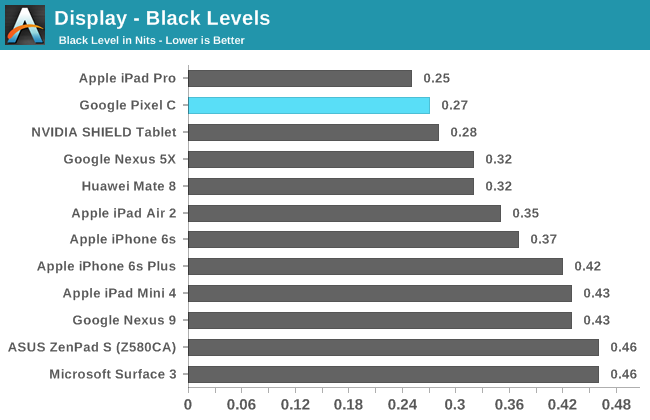
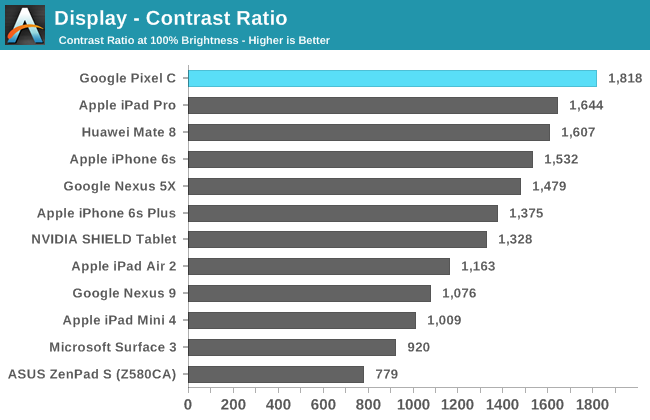
The Pixel C’s display goes up to 495 nits measured at the center of the display, and so Google was quite accurate in their advertisement of 500nits. This is the brightest tablet on record, beating the Nexus 9 by around 25 nits. As I mentioned earlier, the highly reflective glass makes the high brightness levels quite necessary, which will likely end up impacting the real-world battery life that Pixel C owners see. It’s also worth noting that the touch sensor layer is highly visible when light shines on the display, which makes it even more difficult to use outdoors or with overhead lighting. This is something that I’ve only seen managed well on Samsung and Apple devices, and for a flagship Android tablet with a completely custom display I expect better in this regard than what the Pixel C delivers.
In addition to the high brightness, the Pixel C has quite deep black levels for an LCD tablet. With a black level of 0.2718 nits and a contrast ratio of 1818 at max brightness, the Pixel C has the best contrast of any tablet that we’ve seen to date, besting even the iPad Pro.
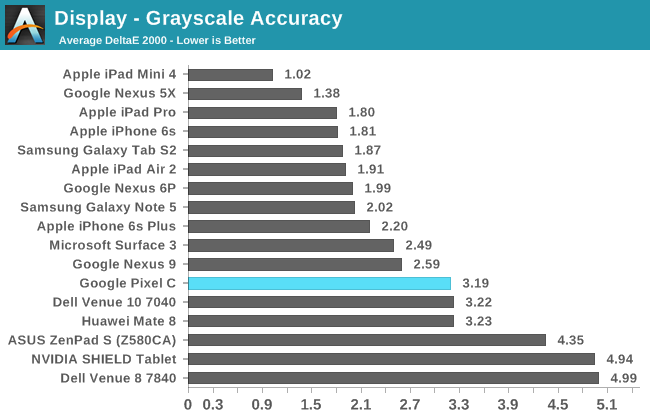
Greyscale accuracy on the Pixel C is fairly good, with a DeltaE error value slightly over the motion-visible value of 3. The error is mostly due to the green component of luminance dropping as you move from black to white. While we certainly have been spoiled by the rapid increase in mobile display quality over the last few years, I do think that Google could have pushed color accuracy higher here. That isn’t to say that I think the Pixel C will disappoint, but considering that it’s an entirely custom panel on a premium device that won’t be shipping in high volume, I think Google could have gone a bit further. Competition is getting fairly fierce in this category, with devices pushing for DeltaE values below 2, and some units achieving values below 1 which would make the error impossible for the eye to detect in any circumstance. In the end, the Pixel C’s greyscale accuracy is quite good, but it’s not the absolute best that I’ve seen.

The Pixel C’s accuracy with rendering primary and secondary color saturations is excellent. With an average DeltaE value below 2, I doubt any person will find themselves bothered by what little inaccuracy there is. The only color that actually exhibits an error above 3 is 100% red, with the remaining values all sitting below.
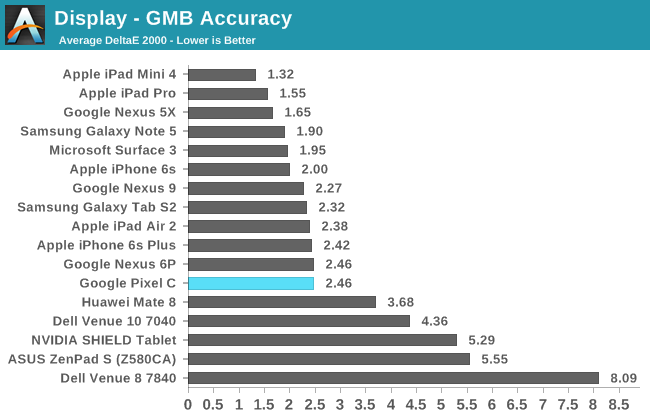
The Pixel C does quite well in the Gretag-MacBeth ColorChecker test. The average error is below 3, with the only outliers being color mixtures that primarily have a blue component, along with the greyscale values that are included in the test. Most other colors have DeltaE values somewhere between 1 and 2, and with that kind of accuracy I don’t really have any complaints, even if it’s not the absolute best result that I’ve ever seen.
In the end, the Pixel C comes with a bright, accurate, and high resolution display, with one of the highest contrast ratios that I’ve seen on a tablet. Google could definitely improve greyscale performance a little, and all companies need to start applying the same sort of anti-reflective coatings that Apple applies to their iPads, because the difference in outdoor usability is dramatic when you compare them. The Pixel C’s high reflectivity has been a noticeable obstacle when using it in environments that have overhead lighting, which includes my own home. That kind of little detail is the sort of thing that, when properly recognized and addressed, can really take a product to the next level. As it is, the Pixel C’s display is very good in many respects, but among high end tablets it’s not one I can call the absolute best.



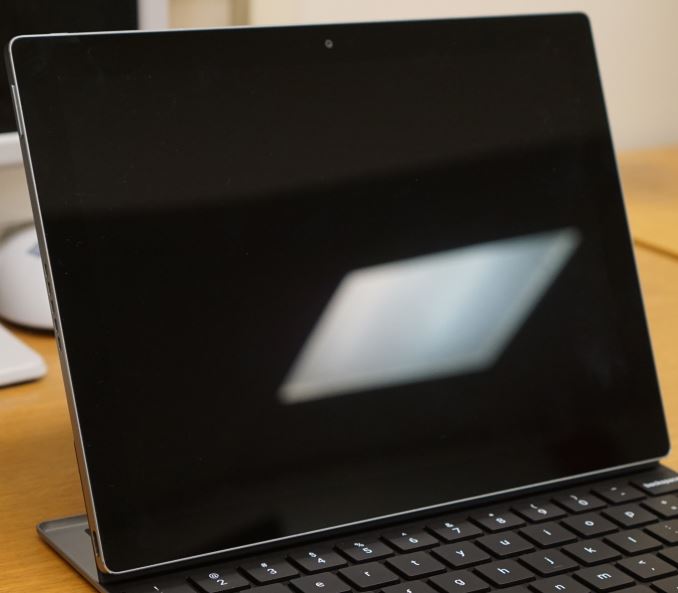
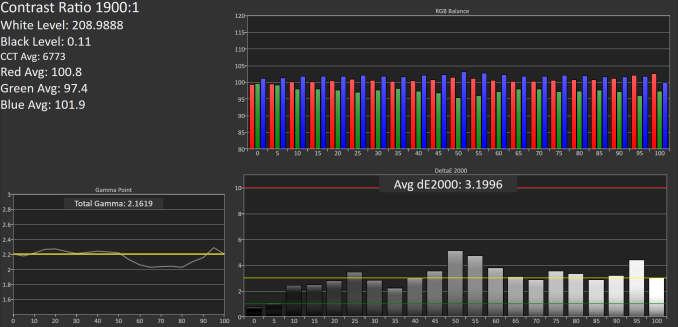

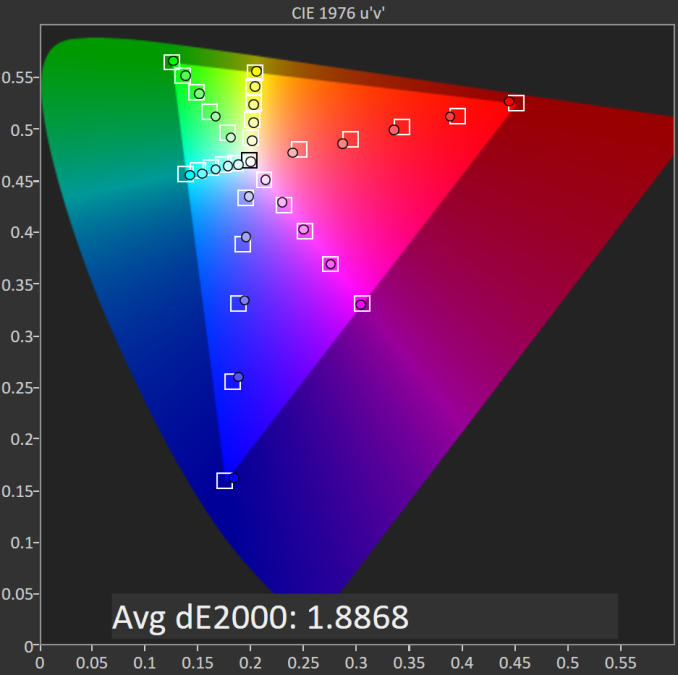









122 Comments
View All Comments
Laxaa - Tuesday, January 26, 2016 - link
It seems to me like the Pixel C was released a year or two too early.versesuvius - Tuesday, January 26, 2016 - link
Adding a keyboard to an ARM device is just adding insult to injury. ARM devices are never going to be useful beyond what they were intended to be in the first instance, which is content consuming devices. Their advantage, which is size and power consumption, is also their limitation. If any company tries to sell an ARM device with a keyboard, one can be pretty sure that that company is pretty much at the end of the road. Disabling four cores of the processor on the top device from the company, while pushing a keyboard on buyers, just says it all. It says that the buyer was not going to do anything useful with it anyway, that is with this device from this particular company anyway.hMunster - Tuesday, January 26, 2016 - link
How can you appload the battery run time and lament the size and weight at the same time?10basetom - Tuesday, January 26, 2016 - link
So the final grade for the Pixel C is a C. Final grade for Android tablet ecosystem? D-Lolimaster - Tuesday, January 26, 2016 - link
How can you release a tablet without SD reader, come on.This tablet would be perfect for reading my collection comics&manga, I don't want to rely on the internetz just for reading purposes.
Demigod79 - Tuesday, January 26, 2016 - link
A couple of years ago I attached a keyboard case to a Nexus 10 and tried to use it like a laptop. It failed. Even though the Nexus 10 supported keyboard navigation and mouse input I found it difficult to anything really productive, and having a keyboard cover on it limited its functionality as a tablet. The Pixel C seems to be a modern-day rehash of my failed experiment with the Nexus 10 and I can very well imagine how using it would be (that is, very bad).The thing is, I had thought Android tablets would gradually evolve and grow, incorporating desktop features like expanded storage and windows apps. The latter was something that I particularly desired ever since using Samsung tablets that had pop-up apps. I thought this was the future and hoped Google would adopt and expand it to incorporate all apps. Frankly, I never thought tablets should have tablet versions of apps. In my opinion, running one app at a time was largely due to the limited screen space available on a phone, which obviously didn't apply to tablets. I thought the natural thing to do with a tablet was to run those phone apps in separate windows, not have bigger versions of those apps. I dreamed of the day when I would be able to run multiple Android apps at once like I did on my laptop.
I waited in vain for Google to incorporate windows apps, and then last year I got fed up and bought a Surface Pro 4 instead. It was the best decision I had ever made. Not only can the Surface Pro 4 replace my laptop (haven't touched it since) it can also replace my tablet since I can run Bluestacks (Android emulator) on it. Best of all, I can finally run Android apps in a window like I've always wanted to do. Add in the ability to run desktop applications as well as desktop games through Steam and it easily ranks as the best mobile device I've ever bought. I have given up on Microsoft for a while but it now seems to be the future (Android had the potential to be the future but Google squandered the opportunity, and now they are relegated to creating lame products like the Pixel C).
deppman - Friday, January 29, 2016 - link
I agree, although I prefer Ubuntu as my general purpose OS since it is more appropriate for my needs.Have you seen Jive's Remix OS? It's pretty much what you describe, and it's run by ex googlers. I expect Google to buy them out because the evolution is so obvious and correct. It's my guess that internal political BS is what has happened here. If they simply added windowed ART apps to chrome OS - or windowed apps and a full chrome browser build to android, they'd achieve pretty much what you described.
IMO, they are missing a wonderful opportunity to unseat MS as the primary desktop OS by not resolving this obvious elephant in the room.
Nisthar - Wednesday, January 27, 2016 - link
Hi Guys, This is a contest hosted by one of the members in my site. He needs a review on Lenovo k4 note + AntVR headset. You can view the contest http://reviewill.com/contest/2 . You may need to register to apply for the contest. The requirements for the contest would be mentioned in the contest description written by him. The winner will recieve $150.Ways to earn money in the site:
1. You can earn through referring your friends. You will get $1 for every 10 users that you refer. The referrals should be verified.
2. You can earn big money through cpa offers.
3. You can post interesting stories through quickpost.
4. You can get 100% user written custom reviews on any brands, companies, movies, etc.
Sign up: http://reviewill.com/register
Sorry if it disturbed you :)
alexlaoe - Wednesday, January 27, 2016 - link
Runs very well. Just bought one and I love the beauty behind the design.https://open.spotify.com/user/artistm/playlist/1RC...
Rc1138 - Sunday, January 31, 2016 - link
Despite my love for big tablets I can't bring myself to like this device. Making a "productivity" tablet is just too early for android. I have a really old nexus 10 and it's nand perfomance as well as overall stability(touch,wi-fi and apps) is several times better than this halfassed powerhouse. The only thing I like about Pixel C is battery perfomance(both battery life and charge time) because nexus 10's charge time equals it's web browsing time(roughly 7 hours). I can't think of a targeted group this tablet is aimed for because for the same price you can buy a really sophisticated surface 3